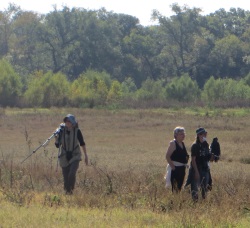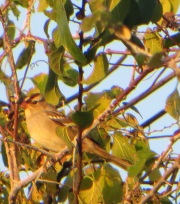
Once upon a time, not far from downtown high rises, the greens and ponds of a golf course took over a portion of forested river bottomland. The river, having a mind of its own, would periodically flood out the golf course. The players complained about the mosquitoes and the stench of sewage from the treatment plant not far upstream.
Concerned about the quality of the water, and needing an outlet to lower the river's flood levels near downtown, someone decided to do something. The City took over the courses, much to the unfortunate owner's chagrin, and partnered with experts to remake the land. Where fairways once stood, now wetland ponds flow, further cleaning the already-treated waters. The greens were pulled up and natives plants installed, leading to a beautiful renaissance of prairie grasses, wildflowers, and their marshy kin too.
And the animals, driven out by human development, returned to the land. Especially the birds. And people returned as well, to fish and hike - and to count the birds. 158 different species were seen in four years of observations, tallied by diligent volunteers.
But how many volunteers, and how many hours have they put into monitoring the return of ecological diversity to this site? Were some parts of the area better than others - more diverse or with greater populations? Is there any way for participants and the public to easily see what's going on?
For lovers of nature, and for pragmatists who see the value of using a natural system to filter water and lower the impact of flooding, the return of meadows and wetlands is a happy *beginning* to a long story of restoring balance with an urban ecosystem. This story is one that repeats itself all across the land, from the great prairies to the mountains, and from the cities to the coasts. The details differ - restoration in one locale, and preservation in another - but the needs are the same.
And thus, this story leads to opportunity: to develop a web site platform that can provide for more detailed data collection, as well as volunteer tracking and stakeholder engagement. The story is a real one, exemplifying the role of citizen-science volunteers in monitoring the rehabilitation of the land. And while that particular project might never use the platform, there is real demand in other quarters. Citizen-science, it is time to meet your ideological cousin: open source.

Volunteer birders hiking through the prairie.

White Crowned Sparrow in a netleaf hackberry tree.
Additional reading on the Dallas Floodway Extension Project

All photos by Stephen A. Fuqua.
Posted with : FlightNode: Citizen Science Bird-Monitoring